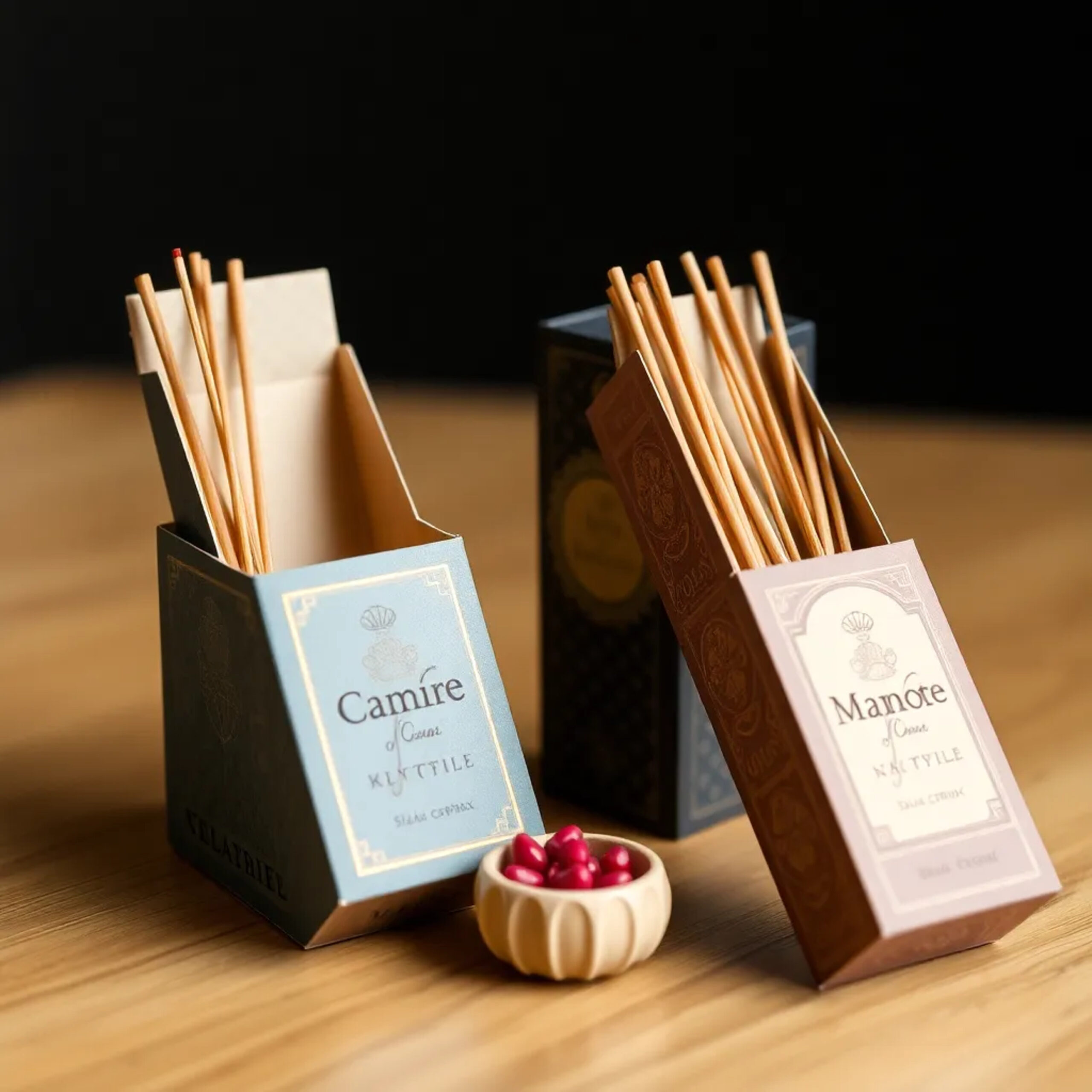What You Need To Know About Designing Incense Stick Packaging
Designing incense stick packaging is more than just an aesthetic choice it’s about creating a functional and appealing solution that protects the product, preserves its fragrance, and communicates the brand’s values. As incense products are often associated with relaxation, spirituality, and wellness, the packaging plays a crucial role in conveying these attributes. Here’s a detailed guide on what you need to know about designing incense stick packaging, covering essential features, material choices, and design elements.
Understanding The Purpose Of Incense Stick Packaging
The primary function of incense stick packaging is to protect the delicate sticks and preserve their fragrance. Incense sticks are fragile, and their fragrance can easily dissipate when exposed to air or moisture. Therefore, the packaging should keep the incense intact, shield it from external elements, and maintain its aromatic qualities.
Additionally, packaging serves a marketing function. It’s the first thing a consumer notices, and it can make a significant impact on their buying decision. Well-designed packaging can elevate the perceived value of the product, making it stand out on the shelf and enhancing the overall customer experience.
Choosing The Right Materials
The choice of materials is critical when designing incense stick packaging. You need to select materials that provide both durability and a sensory appeal. Common materials for incense packaging include:
- Cardboard: Cardboard is a popular and cost-effective choice for incense packaging. It’s lightweight, sturdy, and offers excellent printability. Custom incense boxes made from cardboard can easily accommodate delicate sticks and provide space for branding and product information.
- Kraft Paper: Known for its eco-friendly properties, kraft paper is biodegradable and offers a natural, rustic aesthetic. It’s an excellent choice for brands focused on sustainability, as it’s both durable and environmentally conscious.
- Plastic: While less common, some incense packaging uses plastic. This material can provide airtight sealing to preserve fragrance, though eco-friendly alternatives like biodegradable plastics are increasingly being sought after.
- Wood: Premium incense brands often use wooden boxes or containers for a more luxurious and sustainable appeal. Wood provides an upscale feel while offering excellent protection for the product.
- Metal: Tin or aluminum containers are also used for incense packaging, especially in the case of premium incense sticks. These materials provide strong protection and keep the incense safe from moisture and air, while also offering a sleek, modern look.
Fragrance Preservation
One of the main concerns with incense is its delicate fragrance, which can easily degrade if exposed to air or moisture. Packaging plays a significant role in preserving this aromatic quality. To ensure that the incense sticks maintain their freshness, consider the following packaging features:
- Airtight Packaging: Airtight containers or boxes with seals are ideal for keeping incense sticks fresh. Vacuum-sealed packaging is also an effective solution for locking in the fragrance.
- Foil Linings: Some incense packaging features foil lining or foil pouches inside the box to create a protective barrier against air and moisture. This helps preserve the fragrance for a longer period.
- Re-sealable Bags or Boxes: For convenience and to maintain freshness, some brands use resealable bags or boxes, allowing customers to close the packaging tightly after use.
Designing With Brand Identity In Mind
The packaging of your incense sticks is a powerful tool for communicating your brand’s identity. It should reflect your product’s values, whether it’s relaxation, spirituality, wellness, or luxury. Consider the following elements when designing your packaging:
- Color Palette: Choose colors that resonate with your brand’s message. Earthy tones like browns, greens, and beiges can evoke a natural, calming feel, while vibrant colors might appeal to a younger, more energetic audience. For luxury incense, gold, silver, or dark hues can convey an upscale, premium product.
- Typography: The choice of fonts should align with the product’s personality. For a spiritual or wellness-focused brand, gentle, flowing fonts can add to the soothing experience. Bold and modern fonts may work better for brands aiming for a contemporary look.
- Brand Logos and Imagery: Incorporating your logo and imagery into the design helps create brand recognition. Nature-inspired designs like flowers, trees, or spiritual symbols can be effective for incense packaging, conveying tranquility and mindfulness.
- Minimalism vs. Detail: Depending on your brand’s identity, the design can either be minimalist or detailed. Some brands choose simple, elegant designs to promote a sense of purity and simplicity, while others may opt for intricate patterns or culturally significant designs to highlight the incense’s heritage or purpose.
Functionality And Convenience
In addition to aesthetics, incense packaging must be functional and convenient for consumers. Some features to consider include:
- Easy Opening and Closing: Incense packaging should be easy to open and close without damaging the product. Consider using flip-top boxes, slide-out trays, or resealable pouches for convenience.
- Single vs. Multi-Pack: Decide whether your incense packaging will house individual sticks or multi-packs. Packaging for individual sticks might be simpler and more compact, while multi-packs require larger, more robust boxes that protect multiple sets of incense.
- Internal Dividers or Sleeves: For incense sticks that come in bulk or multiple pieces, internal dividers or sleeves help prevent the sticks from tangling or breaking. This is especially important for longer incense sticks, as they can easily get damaged during handling.
Sustainability In Packaging
Eco-friendly packaging is a growing trend in the incense industry, driven by consumers who are more conscious of environmental impact. Opting for sustainable materials and production methods can enhance your brand’s appeal to environmentally-minded customers.
- Recyclable and Biodegradable Materials: Packaging made from recyclable paperboard, kraft paper, or biodegradable plastics is a great way to promote sustainability while maintaining product quality.
- Minimalist Packaging: Reducing excess packaging, such as using fewer layers or avoiding unnecessary plastic, can help lower environmental impact. Additionally, using materials that can be easily reused or repurposed by customers can add value to your product.
Cost-Effectiveness And Bulk Ordering
When designing incense stick packaging, consider the cost of production, especially if you plan to produce in bulk. Custom packaging can be more expensive than standard packaging, so it’s essential to balance quality with affordability. Bulk ordering incense packaging from suppliers can help reduce costs significantly.
Wholesale packaging allows you to order large quantities, which is ideal for incense businesses that want to streamline production and save money on materials.
Packaging For Different Types Of Incense
Different types of incense products require distinct packaging solutions. For instance, incense sticks are typically packaged in long, narrow boxes, while incense cones may be better suited for small, compact boxes or tins. Additionally, packaged incense may require boxes that are specifically designed to hold loose incense powder or resin.
- Incense Stick Packaging: Long rectangular boxes are the most common for incense sticks, with protective inserts to keep the sticks intact and prevent bending.
- Incense Cone Packaging: Incense cones are usually packaged in smaller containers, such as cylindrical tubes, jars, or small boxes.
- Loose Incense Packaging: Loose incense powder or resin can be packaged in small bags or jars, often with labels detailing the product’s ingredients and usage.
Conclusion
Designing incense stick packaging requires a balance of functionality, aesthetics, and sustainability. The right packaging not only ensures the product is protected and the fragrance is preserved but also helps communicate the brand’s identity and values. By considering material choices, branding, user experience, and eco-friendliness, you can create packaging that resonates with customers and enhances their experience. Whether you’re working on custom incense packaging for a luxury brand or looking for eco-friendly packaging solutions, the right design can set your product apart in a competitive market.














Post Comment